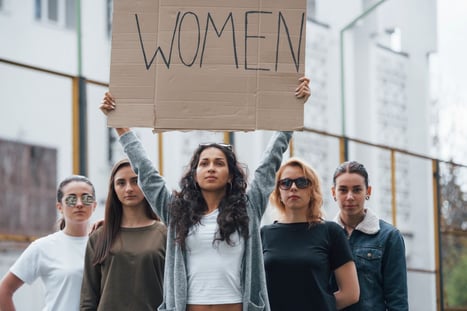Contraception and the women’s liberation movement were some of the most important factors leading to the passing of the Equal Rights Amendment.
 Reproductive Control. Although the contraceptive Pill first went to market in 1960, it was not widely available until the early 1970s. In 1999, The Economist magazine named The Pill
Reproductive Control. Although the contraceptive Pill first went to market in 1960, it was not widely available until the early 1970s. In 1999, The Economist magazine named The Pill  the invention that defined the twentieth century. And it is no coincidence that when the birth control pill became widely available, the number of young women applying to post-secondary schools dramatically increased. It allowed young women to decide when to have children and gave them the confidence to begin careers that required longer education and training.
the invention that defined the twentieth century. And it is no coincidence that when the birth control pill became widely available, the number of young women applying to post-secondary schools dramatically increased. It allowed young women to decide when to have children and gave them the confidence to begin careers that required longer education and training.
The nuclear family shifted during the 1960s and 1970s. Divorce rates increased, and it was more common to see unmarried couples living together. Single mothers also became more normalized. The message was clear to young women that they needed to be more independent and not count on marriage for their security.
The Influence of the Civil Rights Movement. Finally, the Civil Rights Movement influenced the feminists of the 60s. They learned lessons from the struggles and successes of the black community. After coming to grips with the realities of racism in America, young people were more willing to question traditional cultural norms, which opened the way for others who had been discriminated against to stand up and fight. It was the perfect storm for the Women’s Liberation movement to take shape and grow.
➡️➡️ Read More: 09_Is This All?
Gail Collins explains the change in the movement, “The first wave won the ballot but failed to eliminate the wall between women and the male-controlled public world. The second wave wanted an equal role in everything – business, the arts, sports, politics, science, and academia. It had begun a couple of years earlier, in Betty Friedan’s hotel room in Washington. Now it was about to explode into a movement that included reformers such as Friedan and revolutionaries such as New York Radical Women, with countless students, factory workers, teachers, and housewives in between. It was a moment when history opened to every woman ready to join a march, start a consciousness-raising group, or give her daughter a baseball and bat for Christmas.”
Women’s Lib Leadership Emerges. Many women were protesting, but there was no unifying voice. Some radicals envisioned a world with no men, while reformers such as the National Organization of Women simply wanted to create a fairer world where both sexes could work together. There were many viewpoints, and local chapters focused on different issues. Regardless of organizational unity, the movement grew and evolved.
 In 1972, Ms. magazine was founded by activists Gloria Steinem and Dorothy Pittman Hughes. The first issue sold out in eight days and generated more than 26,000 subscribers. Steinem became the face and spokesperson of the women’s lib movement in the 70s. Betty Friedan had woken up a generation of women, and Steinem brought more women into the fold with her approachable style and near-celebrity status. She served as a symbol that women could be intelligent, beautiful, and demanding of their rights.
In 1972, Ms. magazine was founded by activists Gloria Steinem and Dorothy Pittman Hughes. The first issue sold out in eight days and generated more than 26,000 subscribers. Steinem became the face and spokesperson of the women’s lib movement in the 70s. Betty Friedan had woken up a generation of women, and Steinem brought more women into the fold with her approachable style and near-celebrity status. She served as a symbol that women could be intelligent, beautiful, and demanding of their rights.
In 1970, Betty Friedan stepped down as the head of NOW. In her farewell speech, she called on every working woman to stop and take to the streets on August 26, the 50th anniversary of the 19th Amendment. Thousands of women marched across America on that day as a strike for equality. In her post-march speech, Freidan said, “In the religion of my ancestors, there was a prayer that Jewish men said every morning. They prayed, ‘Thank thee, Lord, that I was not born a woman.’ Today I feel, feel for the first time, feel absolutely sure that all women are going to be able to say, as I say tonight, ‘Thank thee, Lord, that I was born a woman for this day.’”
➡️➡️ Read More: 08_The Myth of the Ideal Woman
Things were changing in ways big and small, and America was feeling it. Women were fighting for rights, and their voices were being heard. In 1974, the Equal Credit Opportunity Act became law which prohibited discrimination in lending. Title IX prohibited sex discrimination in federally funded education programs. People seemed to be on board with equal rights for women. Many states reformed their laws to reduce discriminatory practices. Everything was aligned for the passage of the Equal Rights Amendment.
 ERA Passes Congress. At 85, Alice Paul was in D.C. orchestrating the final details. Women were pressuring the members through extensive networking, and Representative Martha Griffiths was forcing the ERA through the House. The Equal Rights Amendment is simple and reads, “Equality of rights under the law shall not be denied or abridged by the United States or by any state on account of sex.” The ERA passed the House in 1971 with a vote of 352 to 15 after only an hour of debate - the first time the House had acted on it since its introduction in 1923. The Senate held out longer due to resistance, such as N.C. Senator Sam Ervin who said, “Keep the law responsible where the good Lord put it – on the man to bear the burdens of support and the women to bear the children.”
ERA Passes Congress. At 85, Alice Paul was in D.C. orchestrating the final details. Women were pressuring the members through extensive networking, and Representative Martha Griffiths was forcing the ERA through the House. The Equal Rights Amendment is simple and reads, “Equality of rights under the law shall not be denied or abridged by the United States or by any state on account of sex.” The ERA passed the House in 1971 with a vote of 352 to 15 after only an hour of debate - the first time the House had acted on it since its introduction in 1923. The Senate held out longer due to resistance, such as N.C. Senator Sam Ervin who said, “Keep the law responsible where the good Lord put it – on the man to bear the burdens of support and the women to bear the children.”
➡️➡️ Read More: 07_A Woman’s Place
In 1972, the amendment finally passed Congress and needed 38 states to ratify for the Constitution to be amended. Hawaii was the first state to ratify within minutes of the passage. Within two days, six states unanimously ratified it, and 24 more states quickly followed. However, the momentum eventually died, and the backlash began with only three states remaining to ratify.
Women in the Workforce: We Can Do It!
Whether married or single, with children or not, working part-time, full-time, or even two jobs, as a stay-at-home mom or a community volunteer, American women can do it! Throughout history, American women always have. And I am so proud we do! Over the next few months, I will explore how topics about women in the workforce from the early 1900s until the present. Also, I want to note the changing trends of women in the workforce that this series contemplates will focus on white, middle-class women. Women of color have had very different experiences, and their work lives have been defined by racism, sexism, and financial necessity. I have pointed this out when possible, but please keep in mind that this series is not a complete picture of all women.
This is Part 10 of a 14-part series, Women in the Workforce: We Can Do It!, which explores topics related to the history, challenges, and accomplishments of working women in America. Topics to date include: 01_Women in the Workforce: We Can Do It!, 02_The War Opens the Doors for Working Women, 03_Rise of Jobs, Rise of Inequality, 04_Working Women and The Great Depression, 05 The Rise of Female Empowerment, 06_Stay Home or Be Paid Less and 07_A Woman's Place, 08_The Myth of the Ideal Woman and 09_Is This All?
Propel HR President Lee Yarborough
 “My father, Braxton Cutchin, and I founded the company in 1996. After being in the PEO and HR world for 25 years, I have experienced firsthand the value we can provide to both the clients and the employees. It is truly a win for all parties. I’m proud to have helped establish Propel HR as an industry forerunner in the Southeast. There is nothing I love more than receiving phone calls from clients who seek my advice as a trusted advisor. This is a business where I feel that I can help others, and that is important to my own value.”
“My father, Braxton Cutchin, and I founded the company in 1996. After being in the PEO and HR world for 25 years, I have experienced firsthand the value we can provide to both the clients and the employees. It is truly a win for all parties. I’m proud to have helped establish Propel HR as an industry forerunner in the Southeast. There is nothing I love more than receiving phone calls from clients who seek my advice as a trusted advisor. This is a business where I feel that I can help others, and that is important to my own value.”
-- Lee Yarborough, President, Propel HR
Active in many professional and community organizations, Lee recently served as Chair of the Board of Directors of the National Association of Professional Employer Organizations (NAPEO). As NAPEO Chair, Lee focused on diversity and initiatives to deepen member relations. Under her leadership, she formed Women in NAPEO (WIN), a networking group designed to engage, empower, and encourage women working in the PEO industry. On the local level, Lee also served as the Chair of NAPEO’s Carolinas Leadership Council for more than a decade. In 2015, she was named a Fellow of the eleventh class of the Liberty Fellowship Program and a member of the Aspen Global Leadership Network.
An advocate for public education, Lee has served on the executive board as Chair of Public Education Partners and is the founder and director of Read Up Greenville, a young adult and middle grades book festival in downtown Greenville, SC.
When she breaks from board meetings, client visits, and networking, most likely, you will find Lee reading, camping, or spending time with her family. She also enjoys volunteering at her church and staying involved with her children's schools.
 About Propel HR. Propel HR is an IRS-certified PEO that has been a leading provider of human resources and payroll solutions for more than 25 years. Propel partners with small to midsized businesses to manage payroll, employee benefits, compliance and risks, and other HR functions in a way that maximizes efficiency and reduces costs. Visit our new website, www.propelhr.com.
About Propel HR. Propel HR is an IRS-certified PEO that has been a leading provider of human resources and payroll solutions for more than 25 years. Propel partners with small to midsized businesses to manage payroll, employee benefits, compliance and risks, and other HR functions in a way that maximizes efficiency and reduces costs. Visit our new website, www.propelhr.com.









